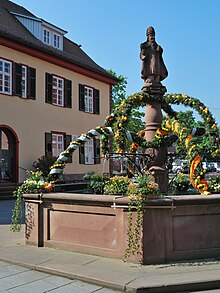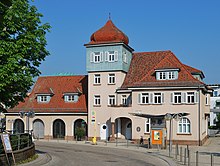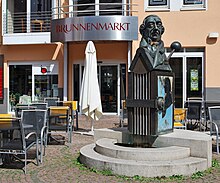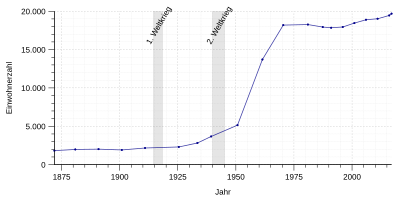Gerlingen
| coat of arms | Germany map | |
|---|---|---|
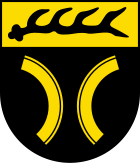
|
Coordinates: 48 ° 48 ' N , 9 ° 4' E |
|
| Basic data | ||
| State : | Baden-Württemberg | |
| Administrative region : | Stuttgart | |
| County : | Ludwigsburg | |
| Height : | 336 m above sea level NHN | |
| Area : | 17.01 km 2 | |
| Residents: | 19,745 (Dec. 31, 2018) | |
| Population density : | 1161 inhabitants per km 2 | |
| Postal code : | 70839 | |
| Area code : | 07156 | |
| License plate : | LB, VAI | |
| Community key : | 08 1 18 019 | |
| LOCODE : | DE GLG | |
City administration address : |
Rathausplatz 1 70839 Gerlingen |
|
| Website : | ||
| Mayor : | Dirk Oestringer ( independent ) | |
| Location of the city of Gerlingen in the Ludwigsburg district | ||
Gerlingen is a town northwest of Stuttgart and about ten kilometers from the district town of Ludwigsburg in Baden-Württemberg in the Ludwigsburg district . It belongs to the Stuttgart region (until 1992 the Middle Neckar region ) and the European metropolitan region of Stuttgart .
geography
Gerlingen is the southernmost municipality in the Ludwigsburg district and is 336 meters above sea level .
City structure
Gerlingen includes the city of Gerlingen, the districts of Gehenbühl and Schillerhöhe and the houses of Bopser, Forchenrain, Gerlinger Heide, Glemstal, Krummbachtal and Stöckach as well as the abandoned villages of Hausen am Gerlinger See, Höferle and Richtenberg Castle .
Neighboring communities
Gerlingen borders in the north on the city of Ditzingen , which is also located in the Ludwigsburg district; in the east to the urban district of the state capital Stuttgart (districts Hausen, Giebel, Bergheim, Solitude , Wildpark and Büsnau); in the west to the city of Leonberg in the Boeblingen district .
Division of space

According to data from the State Statistical Office , as of 2014.
Natural geography
The urban area is naturally divided into two quite different parts. In the north, Gerlingen has a share in the south-western Neckar basin and in particular in the southern southern Strohgäurand as well as in the Langen Feld , quite flat, loess- covered gauze landscapes that were mainly used for agricultural purposes before the settlement expansion . In the south, the town area extends over the Keuper of the northern heights Glems forest as far as the running of the upper Glems ; this part is hardly populated except on the ascent in the north, here is the Krummbach valley with significant occurrences of amphibians. The Gerlinger Heide nature reserve is marked on the ascent on the western border of the city to Leonberg.
history
Prehistory and early history
It is not known whether people lived in the Gerlinger district as early as the Paleolithic. The only finds from this period consist of three pieces of a mammoth's tooth , which were found in 1955 during sewer work. The first traces of settlement of the linear ceramic culture can be seen in the early Neolithic . When in 1972 the remains of the settlement including devices made of fire and other rocks and bones along with pottery shards were excavated, Gerlingen is considered the oldest ceramic village in Württemberg. Among these finds is a noticeable smaller foot vessel, which probably originates from south-eastern Europe. In 1994 remnants of the "Hinkelstein culture" and the "Großgartacher culture" (approx. 4800-4600 BC) were found. For the period around 4700-4300 BC. A settlement of the "Rössen culture" is proven. From the findings it can be concluded that at the end of the 5th millennium BC BC Members of the so-called " Schwieberdinger culture " lived in the area of today's Gerlingen. The "Schwieberdinger culture" was then superseded by the culture that finally spread throughout Central Europe, namely by the "Michelsberg culture". As early as 1935, the remains of a ceramics attributable to this culture were found during the construction of the motorway. Only a few pottery shards prove the continuation of the settlement of the Gerlinger Markung during the Bronze Age . However, an urn grave damaged by a plow shows that the method of burial in the Strohgäu also adapted to the new times. The so-called urn field culture marks the end of the Bronze Age in archeology.
A new group of people, which spread to Britain in the 5th century BC, has been proven to have reached southwest Germany as early as the 6th century: the Celts . The grave of the Celtic prince of Hochdorf , which is only a few kilometers as the crow flies from Gerlingen, is famous . This Celtic prince is attributed to the Hallstatt period, which also left traces in Gerlingen. Three settlements and a burial mound field from this time are known here, although they were largely destroyed by construction work. Settlement continued in the Latène period , which followed the Hallstatt period , as can be demonstrated by the findings of broken fragments.
Time of the Romans and Alemanni
The Romans also settled at the foot of the Schillerhöhe, which rises above Gerlingen. The remains of two Roman manors, which came to light as early as 1840, are witnesses of Roman settlers. In addition to relatively inconspicuous wall remains, a well and the ruins of a Roman pottery, the remains of underfloor heating were also found.
The rule of the Romans in southwest Germany ended with the arrival of the Alemanni in 259/260. Grave finds since 1880 show that they also settled in Gerlingen. Swords, lance tips, and even jewelry discovered in them prove their presence.
Early Middle Ages
The first evidence of "modern" history of the place Gerlingen comes from the year 797 with the first documentary mention as Gerringen in the Lorsch Codex on the occasion of a donation to the monastery Lorsch . Another donation is recorded in 814. In 902, however, the monastery exchanged its property in the Strohgäu with a certain Reginbodo for a large court in Viernheim .
middle Ages
In the Middle Ages , the Gerlingen mark belonged to a family of knights whose members were servants of the Counts of Calw . Around 1100 a Benso de Gerringen (original spelling for Gerlingen) was mentioned in the Hirsauer Codex , around 1120 an Adalbertus. In 1150 the name of a Wortwinus, a feudal man, Duke Welf VI, appeared. The traditional coat of arms of the Knights of Gerringen, whose members can still be traced back to the 14th century, was integrated into the coat of arms of the Gerlingen community in 1937. Their castle, Richtenberg Castle , which they built on the heights above Gerlingen, had to withstand a siege according to tradition in 1311/12. The remains of Richtenberg Castle were still visible until the 19th century, as can be seen on a land map from 1827.
In the middle of the 14th century Gerlingen came to the Württemberg bailiwick (the office) of Leonberg , as can be seen from a document that named the first bailiff in 1347. After Leonberg, the taxes had to be paid, which were recorded in the so-called "Leonberger Arbaren". Customs and law were recorded in the “Gerlinger Dorfbuch”. A surviving copy from 1485 provides information on immigration and marriage fees. Gerlingen has had its own school since 1559.
17th century
In July 1622 the Thirty Years War arrived in the village of Gerlingen. The soldiers of the Leonberg district, to which Gerlingen had belonged since the 14th century, were drafted and had to do their duty as border guards near Maulbronn , where they made acquaintance with the wild troops of Imperial Field Marshal Tilly in a bloody battle. Gerlingen was not spared from marching through and billeting enemy soldiers. In the years 1634 to 1638 the Catholic general of the Emperor Mathias Graf von Gallas quartered himself in the Oberamt Leonberg, to which the Gerlingers had to deliver money and natural produce. In addition there was the plague , from which many Gerlingers died in 1635 in particular. In total, the war and plague in the village of Gerlingen killed around 800 people. The pre-war population could only be reached again 170 years later. The resulting misery called the "prophet" Hans Keil on the scene in 1648 , whose story was spread by bailiff singers on the marketplaces throughout southern Germany. In 1669 there was the Gerlinger civil feud, also an expression of the misery of the time after the Thirty Years' War, when the Gerlingers rebelled against the administration of the tithe because of alleged fraud against the local authorities . A witch trial has also come down to us from Gerlingen in 1672. However, this went off relatively lightly for the defendant Margaretha Butzenbach, a 16-year-old mentally disturbed girl.
After the Peace of Westphalia in 1648, the French King Louis XIV managed to expand his territory considerably to the east. Then he raised claims to the Palatinate . In 1688 the French Marshal Duras also made high financial demands on the Duchy of Württemberg , but these were rejected. Thereupon the troops of the French commander General Mélac also moved into Gerlingen. As early as December 1688, Swabian units that had fought against the Turks in Hungary and were now returning to their homeland, succeeded in driving Mélac and his soldiers out again. In July 1693 Gerlingen was again struck by a French army. The villagers sought protection within the Leonberg city walls. Gerlingen's neighboring villages were cremated by the French. Gerlingen was spared that, but the community was forced to billet so-called “ Sauvegardes ” (“protective guards”), for which they also had to pay 600 guilders . In addition, the church bells were stolen from her.
18th century
In the 18th century, Gerlingen suffered from Duke Carl Eugen's chronic lack of money . He not only drove out the famous poet Friedrich Schiller , who lived for a long time at Solitude Castle in Gerlingen , but also sold Gerling citizens as soldiers. In addition, the villagers constantly had to do labor, such as the hard work in the construction of the Solitude summer residence .
The poet's father, Johann Caspar Schiller, ran the largest fruit tree nursery in southern Germany at Schloss Solitude, which belonged to Gerlingen until 1943, thus laying the foundation for extensive orchards. Johann Caspar Schiller was buried just like his daughter Karoline Christiane "Nanette" Schiller in 1796 at the Petruskirche in Gerlingen.
19th century
In the reorganization of the young Kingdom of Württemberg in the early 19th century that survived altwürttembergische Oberamt Leonberg the administrative reform so that Gerlingen to 1938 was associated with this.
In the 19th century, numerous missionaries came from Gerlingen. The two most famous are the "discoverer" of Kilimanjaro, Johannes Rebmann (1820–1876), who worked in East Africa from 1846 to 1875, and the linguist Johannes Zimmermann (1825–1876). The Johannes Rebmann Foundation acquired and renovated the 16th century house where Johannes Rebmann was born, whose owners wanted the house to be demolished in the 1990s, and set up a publicly accessible missionary room in it.
20th and 21st centuries
The First World War (1914–1918) cost 119 Gerlingen soldiers their lives. At its end, the Weimar Republic was proclaimed and, for the first time, German women were also allowed to vote. The participation in the election of the constituent state assembly on January 12, 1919 in Gerlingen was 91.2 percent. In 1926 Gerlingen was connected to the Feuerbach tram network.
At the end of the Weimar Republic, the communists in Gerlingen achieved very good election results, while the NSDAP itself only achieved 36.6 percent in the Reichstag election in March 1933, which was accompanied by repression . The Gerlingen municipal council, however, was brought into line with everyone else in Germany , and mayor Paul Hohly was assigned NS alderman who controlled him. The communists Friedrich Frohnmüller, Willi Grau, Eugen Rebmann and the social democrat Wilhelm Zeeb were taken into "protective custody" on the Heuberg . During the administrative reform during the Nazi era in Württemberg , Gerlingen came to the newly established district of Leonberg in 1938 . As early as 1938 began recording all conscript Gerlinger and in summer 1939 the vintages from 1910 to 1928 had to muster arrive. A year later the first French prisoners of war arrived for labor service. In World War II, fell 154 Gerlinger soldiers and seven civilians. The Allied air raids from 1942 to 1945 destroyed 68 buildings in Gerlingen and damaged many more.
Another consequence of the Nazi era for Gerlingen means the loss of the solitude that has belonged to the Gerling mark since 1852. The National Socialists planned a district leadership school for the Hitler Youth in the area and thought it would be cheaper to assign the area - in 1943 at least a quarter of the municipality marker, on which the Gerlinger water tank was also located - to the municipality of Stuttgart. After the war, after a bitter struggle, compensation of 300,000 DM can be wrested from the Stuttgarters. The state capital could not be induced to return the area.
Since Gerlingen had become part of the American zone of occupation after the Second World War , the community had belonged to the newly founded state of Württemberg-Baden since 1945 , which was merged into the current state of Baden-Württemberg in 1952.
In 1953 the Schillerhöhe Tuberculosis Sanatorium was opened in the ruins of the unfinished National Socialist Regional Leader School against the decided resistance of the population, from which the Schillerhöhe Clinic , Center for Pneumology , Thoracic Surgery and Respiratory Medicine developed.
On June 30, 1958, the place received city rights , because in just 15 years the population increased from 3800 to 10,000. This was primarily a result of immigration, not least also of numerous displaced persons from Eastern Europe.
In 1969 Gerlingen reached the highest population with just over 19,000 inhabitants, which fluctuated continuously between 18,000 and 19,000 over 40 years, until it rose to almost 20,000 in the 2010s - while at the same time there was a large amount of fields, grassland and the "Schiller's" orchard meadows were and are being built on.
With the dissolution of the district of Leonberg , Gerlingen was added to the district of Ludwigsburg in 1973 .
After the Second World War, Gerlingen also developed economically from a village to a town. Many smaller and larger industrial companies settled here, the largest of which is Robert Bosch GmbH , which has its headquarters on the Gerlinger Schillerhöhe. A swimming pool with sauna, a town hall, a new school complex and a new multi-purpose hall were built. The buildings of the city library are also considered to be a positive example of modern architecture among architects.
Today Gerlingen is a city with an above-average number of high-income households. Reasons for this are on the one hand the proximity to Stuttgart, the good transport connections, the good economic situation and the visually appealing city center, on the other hand also soft location factors such as the diverse club landscape, sufficient kindergarten offers, attractive residential areas with a view of the Strohgäu on the edge of vineyards and orchards and a higher one Forest share of almost 50% of the district.
Population development
Population figures according to the respective area. The numbers are census results (¹) or official updates from the Baden-Württemberg State Statistical Office (only main residences ).
|
|
Religions
The existence of a church in Gerlingen has been proven since 1275. The Petruskirche, which still shapes the cityscape today, was built between 1463 and 1495. Since the introduction of the Reformation in Württemberg in 1535/1536, Gerlingen has been predominantly evangelical . Even today there are four Protestant parishes in the city. A Roman Catholic community emerged with the influx of many refugees, especially from Hungary, after the Second World War. Today there is also an Evangelical Methodist , a New Apostolic and a Free Church congregation. There is also a local assembly of Jehovah's Witnesses in Gerlingen.
politics
Municipal council
The local council in Gerlingen has 22 members. The local elections on May 26, 2019 led to the following final result. The municipal council consists of the elected voluntary councilors and the mayor as chairman. The mayor is entitled to vote in the municipal council.
| Parties and constituencies | % 2019 |
Seats 2019 |
% 2014 |
Seats 2014 |
||
|---|---|---|---|---|---|---|
| CDU | Christian Democratic Union of Germany | 21.88 | 5 | 29.97 | 7th | |
| FW | Free voters | 23.39 | 5 | 23.48 | 5 | |
| Green | Alliance 90 / The Greens | 19.52 | 4th | 14.27 | 3 | |
| SPD | Social Democratic Party of Germany | 9.79 | 2 | 14.19 | 3 | |
| JG | Young Gerlingers | 15.54 | 4th | 11.38 | 3 | |
| FDP | Free Democratic Party | 9.88 | 2 | 6.71 | 1 | |
| total | 100 | 22nd | 100 | 22nd | ||
| voter turnout | 66.49% | 63.42% | ||||
mayor
- 1955–1983: Wilhelm Eberhard (independent)
- 1983–1999: Albrecht Sellner (CDU)
- 1999–2020: Georg Brenner (independent)
- Since Feb. 2020: Dirk Oestringer (independent)
badges and flags
The coat of arms, established in 1937, shows under a golden shield head, inside a black deer pole, in black two turned away golden wheel rims (steering logs). The stag bar stands for belonging to Württemberg , while the wheel rims are taken from the coat of arms of the Lords of Gerlingen. The city flag of Gerlingen is yellow-black.
Town twinning
Gerlingen maintains partnerships with:
-
 Gefell in the state of Thuringia in Germany
Gefell in the state of Thuringia in Germany
-
 Vesoul in the Bourgogne-Franche-Comté region in France since 1964,
Vesoul in the Bourgogne-Franche-Comté region in France since 1964, -
 Tata (Hungary) in Hungary since 1987 and
Tata (Hungary) in Hungary since 1987 and -
 Seaham (Durham) in England since 1988.
Seaham (Durham) in England since 1988. - In 1968 the city sponsored the Landsmannschaft of Germans from Hungary in Baden-Württemberg.

Culture and sights
Museums
In addition to the city and local history museum, there is also a museum for Germans from Hungary in Gerlingen.
building
- The area around the Solitude Palace , built by Duke Carl Eugen in 1763 , with its entire residential area belonged to the municipality (now the city) of Gerlingen until April 1, 1942, then was incorporated into Stuttgart and assigned to the Botnang district . The area of the sanatorium on the Schillerhöhe belonging to the Solitude residential area was returned to the Gerlingen community in 1951. Today the castle belongs to Stuttgart-West .
- The Rebmannhaus (named after Johannes Rebmann) with missionary room , a literature museum , was named " Monument of the Month January 2004" by the Baden-Württemberg Monument Foundation .
Memorials
On March 13, 2008, the artist Gunter Demnig laid the first and so far only Stolperstein in Gerlingen. The small brass plate in the sidewalk in front of the city museum (Weilimdorfer Str. 9) reminds of Johanna Schweizer, born in 1873, who taught handicrafts in Gerlingen from 1897 until she fell ill in 1927 . The teacher, who presumably suffered from depression, was placed in the Weissenau sanatorium in 1931 . On June 10, 1940, Johanna Schweizer was murdered by the National Socialists as part of the T4 euthanasia campaign in the Grafeneck killing center . A plaque commemorating the fate of Johanna Schweizer is also attached to the house wall of the city museum.
Economy and Infrastructure
Viticulture
Gerlingen is a wine-growing place whose vineyards belong to the Weinsteige area in the Remstal-Stuttgart area of the Württemberg wine-growing region .
traffic
Gerlingen is connected to the supra-regional road network by the federal highway 81 (exit 18 Stuttgart-Feuerbach , three kilometers to Gerlingen).
The U6 light rail line (Gerlingen - Hauptbahnhof - Fasanenhof ) connects Gerlingen with the Stuttgart local transport network.
Established businesses
Robert Bosch GmbH , the world's largest automotive supplier, is based in Gerlingen . Mention should also be made of factories or branches of Endress + Hauser Conducta GmbH (measurement technology), Trumpf GmbH + Co KG (mechanical and plant engineering) and Mühleisen GmbH (precision parts). The DEHA Group , a system network of five independent electrical wholesalers, is also based in Gerlingen.
education
In addition to a grammar school (Robert Bosch grammar school) and a secondary school, there are two primary schools: the Pestalozzi school and the Breitwiesenschule. The Pestalozzi School also has a branch in the forest settlement. The Hauptschule and Werkrealschule were closed a few years ago. The city offers five kindergartens and a crèche for the youngest Gerlingers. There are also two Protestant and Roman Catholic kindergartens and a private Montessori kindergarten.
There is also a large adult education center in the listed former fire station.
Supply and disposal
Electricity and gas supply
The owner of the electricity and gas network is Energieversorgung Strohgäu GmbH & Co. KG , a joint venture between the cities of Gerlingen and Korntal-Münchingen and Netze BW GmbH . Gerlingen has a 110 kV substation through which the corresponding lines lead to Leonberg and Ditzingen. In contrast to the line to Leonberg, the line to Ditzingen has two circuits, but one circuit is operated with 20 kV.
Water supply
The entire urban area is supplied by the local municipal waterworks, Städtisches Wasserwerk Gerlingen, exclusively with drinking water from the Bodensee water supply association.
Sewage disposal
The wastewater treatment takes place in the Ditzingen group sewage treatment plant, which is 60 percent owned by Stuttgart and 40 percent owned by Ditzingen and operated by Stadtentwässerung Stuttgart (SES). The treated wastewater is discharged into the Glems .
Waste disposal
Waste disposal is taken over by the waste recycling company of the Ludwigsburg district (AVL), a 100% subsidiary of the Ludwigsburg district. AVL is commissioned to carry out the tasks of avoiding, recycling and disposing of waste on behalf of the Ludwigsburg district.
Personalities
Honorary citizen
- 1892: Johann Jakob Mitschelen, mayor
- 1957: Fritz von Graevenitz , painter and sculptor
- 1967: Otto Schöpfer, city archivist
- 1974: Gottlieb Eisele, local chairman of the Volksbund Deutsche Kriegsgräberfürsorge
- 1983: Friedrich Schaffert, city archivist
- 1983: Wilhelm Eberhard, Mayor
- 2015: Albrecht Sellner, Mayor
sons and daughters of the town
- Jakob Weidle (1670–1740), wine grower and wine researcher
- Johannes Rebmann (1820–1876), missionary, linguist and geographer, “discoverer” of Kilimanjaro in 1848
- Johannes Zimmermann (1825–1876), missionary and linguist
- Wilhelm Gutbrod (1890–1948), founder of the motorcycle factory Standard-Fahrzeugfabrik in Ludwigsburg and the Gutbrod factory in Plochingen am Neckar
- Rainer Wieland (* 1957), lawyer and politician, Vice-President of the European Parliament
- Markus Rösler (* 1961), landscape ecologist and landscape economist, member of the Baden-Württemberg state parliament (Bündnis 90 / Die Grünen), descendant of Johannes Rebmann
- Smudo (* 1968), maiden name Michael Schmidt, singer of the Fantastischen Vier
Connected with Gerlingen
- Norbert Sternmut (* 1958), German writer and painter, grew up in Gerlingen
- Willy Schnell (* 1927), German oboist and university professor, lives in Gerlingen
Web links
Individual evidence
- ↑ State Statistical Office Baden-Württemberg - Population by nationality and gender on December 31, 2018 (CSV file) ( help on this ).
- ^ The state of Baden-Württemberg. Official description by district and municipality. Volume III: Stuttgart District, Middle Neckar Regional Association. Kohlhammer, Stuttgart 1978, ISBN 3-17-004758-2 , pp. 410-411.
- ^ [Gerlingen State Statistical Office, area since 1988 according to actual use] for Gerlingen.
- ^ Friedrich Huttenlocher , Hansjörg Dongus : Geographical land survey: The natural spatial units on sheet 170 Stuttgart. Federal Institute for Regional Studies, Bad Godesberg 1949, revised 1967. → Online map (PDF; 4.0 MB)
- ↑ Minst, Karl Josef [transl.]: Lorscher Codex (Volume 1), Certificate 3555, April 15, 797 - Reg. 2575. In: Heidelberg historical stocks - digital. Heidelberg University Library, p. 214 , accessed on April 16, 2018 .
- ↑ List of places for the Lorsch Codex, Gerlingen , Archivum Laureshamense - digital, Heidelberg University Library.
- ↑ Population development in Baden-Württemberg from 1871 to 2012 ( page no longer available , search in web archives ) Info: The link was automatically marked as defective. Please check the link according to the instructions and then remove this notice.
- ↑ Klaus Wagner, Michael Bosch: Dirk Oestringer becomes the new mayor. In: Stuttgarter-Nachrichten.de. December 1, 2019, accessed December 12, 2019 .
- ↑ The high school's religion course initiates the “Stolperstein” campaign. (PDF) (No longer available online.) In: RB-GG.de (Robert-Bosch-Gymnasium, Gerlingen). March 13, 2008, pp. 41–43 , archived from the original ; accessed on August 18, 2019 .
- ↑ Barbara Riethmüller: Johanna Schweizer - the murdered handicraft teacher . In: Gerlinger women's stories . City of Gerlingen, Women's History Workshop, 2007, p. 56-79 .
- ↑ Johanna Schweizer. In: NS-Euthanasie.de. Retrieved August 18, 2019 .
- ↑ Energy supply Strohgäu: About us. http://www.energieversorgung-strohgaeu.de/,Lde/home/ueber+uns.html , accessed on June 25, 2017.
- ↑ State capital Stuttgart: SES municipal drainage operation. Brochure. Stuttgart 2015.





